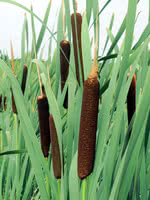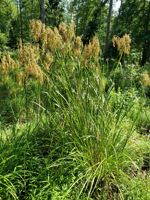Mon-Fri 9am - 5pm Mountain time
Common Cattail vs Woolgrass
Typha latifolia
Scirpus cyperinus
CUSTOM GROW
CUSTOM GROW
Cattail is found all across North America, growing next to water. Like other waterside plants, Cattail provides erosion control and forage for animals.
It is suitable for land reclamation. Cattail is able to tolerate cold weather and occasional flooding.
Woolgrass is a native perennial sedge that forms dense clumps in wetlands, ditches, and along shorelines. Its ability to thrive in saturated soils and shallow water, combined with its spreading growth habit, makes it especially valuable for waterside & riparian plantings, erosion control, ecological restoration, and naturalization projects.
The distinctive spikelets are covered in brown woolly bristles, which is where it gets the name Woolgrass. It produces seeds that are eaten by waterfowl and small mammals, while its dense stems offer cover and nesting habitat. It grows most actively in spring and fall, slowing or going dormant in the summer heat.

